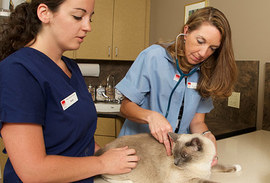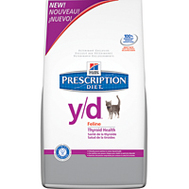|
Brutus, Duke, Coco, Lola and Jake...sure, they're fairly common pet names, but they're also the names of just a few of the pets that died last year because they were left in cars on warm (and not necessarily hot) days while their owners were shopping, visiting friends or family, or running errands. What's so tragic is that these beloved pets were simply the victims of bad judgment. Want numbers? An independent study showed that the interior temperature of vehicles parked in outside temperatures ranging from 72 to 96° F rose steadily as time increased. And cracking the windows doesn't help. ...add to that the fact that most pets are not properly restrained while in the car, and you've got some dangerous situations – for people and pets alike. Unrestrained pets can be seriously or fatally injured, or could even hurt you, in a collision or sudden braking situation. In addition, they're a distraction for the driver, which increases the risk of driver errors. According to a 2010 American Automobile Association (AAA) survey, 2 out of 3 owners engage in distracting behaviors (playing with, feeding or petting their dog, or letting their dog sit in their lap) when pets are in the car...and according to the National Highway Traffic Safety Administration (NHTSA), approximately 20% of injury crashes involve distracted driving. Please don't become another statistic: only take your pets in the vehicle with you when you absolutely need to, and always properly restrain your pets while in the vehicle. How can you help prevent these injuries and deaths?
A Peaceful Farewell provides compassionate at home pet euthanasia to fellow pet owners in Chandler, Gilbert, Mesa, Tempe, Ahwatukee, Scottsdale, and most of the Greater Phoenix Metropolitan Area.
0 Comments
 Can cats get along with dogs? The answer is simply yes, says Dr. Liz Bales, a Philadelphia veterinarian. As long as pet parents take their time and follow a few simple rules for introducing cats to dogs, there’s no reason why felines and canines can’t develop a harmonious relationship. Keep Them Separated If you are bringing a new dog or cat into your home, it’s important that the pet gets adjusted to a new space without the added stress of additional animals right away. In this instance, Bales suggests keeping the cat in a separate environment with plenty of stimulation for several days. A closed bedroom or large bathroom decked out with scratching posts, toys, food, water and the litter box is the perfect option for a new cat. Be sure to also give him a lot of attention during this time. If you’re bringing home a new dog, consider keeping your existing cat in a separate portion of the house and follow crate-training protocol with the dog. Bales suggests placing some of each animal’s personal items—like beds—in the other animal’s space during this time period so that the cat and the dog become accustomed to each other’s scents. You can repeat this process until it’s no longer stressful for both animals. Once your cat is calm, eating well, and using the litter box consistently, it’s time to make the introductions. Keep the First Meeting Quick When you are ready to introduce your cat to your dog, make the initial meeting a quick one—approximately ten minutes. Keep the dog on a leash and allow the cat to roam around and venture as close to the dog as he or she wishes. Use a head collar (halter) on your dog if there is a chance that you may not be in complete control of the situation. Reward your dog with treats and praise for calm behavior around the cat. As long as the process is going smoothly, gradually increase the time the animals spend together. Once you feel comfortable, allow your dog to also move around freely, but keep his or her leash attached so that you can quickly regain control if needed. Be patient—it may take weeks or even months for cats and dogs to finally accept each other and be comfortable. Consider Your Pet’s Personality Dr. Lisa Radosta, a board certified veterinary behaviorist in West Palm Beach, Florida, says that your cat or dog’s personality is a good predictor of his or her ability to get along with another pet. “If your cat has lived with dogs previously and is confident around other animals, you are likely to have an easy transition,” she said. “However, if your cat puffs up, hisses, or runs from other animals, you will have a more difficult time.” Dr. Radosta also says to consider your dog’s personality. “Is he playful but not aggressive? Dogs with this temperament will more easily adapt to a cat. The dog who is lunging, growling, and difficult to control may never be safe with your cat. If this is the case, consult your veterinarian.” If your cat is the confident type and your dog is the easygoing type, it is best to let your cat handle things. Even then, however, the meeting should not be free-for-all. “Put your cat on a higher surface than the dog and put your dog on the leash for the meeting,” Dr. Radosta said. Supervision is Key Keep your cat and dog separated when you cannot directly supervise them until you are fully confident that they present no risk, Dr. Radosta said. The safest way to do this is to keep your dog in a crate. “Even a dog who simply wants to play can seriously or fatally injure a cat,” she said. “Dogs can jump over or bust through baby gates leaving cats in a dangerous situation.” Likewise, you’ll want to provide your cat with a safe place where he or she can escape the dog. This could be a cat tree that the dog cannot climb or a separate room with a cat door installed. “Once cats run, dogs chase. It is very important to prevent this at all costs,” Dr. Radosta said. Brush Up on Your Dog’s Skills In order to help your cat feel safe, your dog has to be under control. He will need to know basic commands such as “leave it,” “sit,” and “stay.” Before the first introduction, make sure to spend time practicing commands with your dog and keep treats handy so that you can reward your dog for good behavior. “When your dog sees the cat, ask him to sit and reward him,” Dr. Radosta said. If the only thing your dog has to do is chase your cat, chasing your cat is going to be his favorite activity. “Keep your dog very well exercised and busy by using food toys and rotating his toys so that he is constantly occupied,” she said. “You can even reserve these fun activities for times when your cat is loose in the house.” Long walks and daily exercise can also help your dog burn off energy—making meetings with the family cat less crazy. You never know which pet is going to be the leader of the pack, but taking the steps to properly introduce a cat to a dog—and practicing patience—will help things run smoothly in your blended-pet household. Source: PetMD / Stacia Friedman A Peaceful Farewell provides compassionate at home pet euthanasia to fellow pet owners in Chandler, Gilbert, Mesa, Tempe, Ahwatukee, Scottsdale, and most of the Greater Phoenix Metropolitan Area.
It may come as a surprise to learn that cats, like the rest of us, tend to favor one paw over the other — that is to say, their left or right. Who knew? But now that you're aware of that interesting bit of trivia, you're probably wondering how to find out if your beloved pet is a righty or a lefty. (You'll be glad you did if you ever run across a good deal on golf clubs for cats, or something.) Well, here to walk us through a simple experiment that will help reveal your kitty's dominant paw is Maru, one of the internet's most famous felines. All you'll need is a cup, a tasty morsel of food and a cat who's willing to join in. That last item, admittedly, might be the hardest to procure. By inviting your cat to fish the treat out of the cup, you can tell which paw is the dominant one by seeing which side he or she uses. Sure, anyone who's ever been on the receiving end of an angry cat's jab knows that they seem more than happy with using either paw in a pinch. But researcher Deborah Wells says that when it comes down to it, they really do seem to show a preference. "The more complex and challenging [the task], the more likely we're going to see true handedness," she told New Scientist. In an actual scientific experiment, similar to the one above, Wells and her colleague Sarah Millsopp at Queen's University Belfast found that handedness in the 42 cats they studied seemed to correspond with their sex. Male cats appeared to be more inclined to be lefties, and females, righties — though at least one male cat was ambidextrous. The reason why is still something of a mystery. Source: The Dodo / Stephen Messenger A Peaceful Farewell provides compassionate at home pet euthanasia to fellow pet owners in Chandler, Gilbert, Mesa, Tempe, Ahwatukee, Scottsdale, and most of the Greater Phoenix Metropolitan Area.
We can’t live without water. But our waters can often be dangerous to us and our pets. A Florida television channel reported last week about the deaths of two men who had contracted a rare flesh destroying bacteria found in salt water. Six others were reported to have been stricken with the same bacteria. Whether the condition was contracted directly from the water, or from oysters or fish from those waters, is still not clear. There have been no reports of dogs being stricken by the same bacterial infection. The incident, however, got me to thinking about the many ways that water can harbor danger to our pets. This post will explore a few. Jellyfish Jellyfish washed onto the shore are a very common finding for beach combers and their beach combing dogs. The tentacles of these creatures have organs that release a stinging toxin whose potency varies with the different species of jelly fish. Even dried out tentacles in the sand or mixed in seaweed can still release the toxin. Dogs that come in contact with the tentacles or bite them can have a mild to serious local allergic reaction, or a more serious anaphylactic reaction resulting in shock. That is exactly what happened to 2-year-old pit bull named Diamond after she bit the tentacles of the most toxic of jellyfish, the Portuguese Man O’ War. After several days in intensive care, including transfusions, Diamond survived and is back to her old self. Many dogs are not that fortunate. If your dog has been stung by jellyfish tentacles, even one of the less toxic species, remove the tentacles without touching them directly with your bare hands and immediately seek veterinary care. Blue-Green Algae Warm weather can promote massive growth of blue-green algae in standing bodies of fresh or brackish (the slightly salty waters of lagoons, estuaries, and ponds near the ocean) waters. The musty or foul smell of the algae is often attractive to dogs. It can cause skin rashes for dogs swimming in the algae infested water. Dogs should be thoroughly washed as soon as possible. For dogs that drink algae contamintaed water, toxins in the algae can affect the kidneys, liver, intestines, and nervous system. Initial symptoms are vomiting, diarrhea, weakness, and difficulty walking. Immediate veterinary care is also advised in these cases. Parasites and Bacteria Standing areas of fresh water like small lakes, ponds, and even puddles can host various parasites and bacteria. Giardia and Cryptosporidium are the most common parasites. These parasites cause gastrointestinal distress resulting in vomiting and diarrhea. Most dogs recover quickly from the infection, but puppies and older dogs with compromised immune systems can be severely affected and need medications and diet modification in order to recover. Leptospirosis can also be found in small bodies of water that have been contaminated by rodents and other small animal that urinate in the water. Although not as common as water-borne parasites, the bacteria is much more dangerous to dogs that drink the contaminated water. Leptospirosis causes kidney damage that can lead to kidney and liver failure. Infected dogs may be lethargic and vomit. With early diagnosis and treatment, dogs do not suffer long-term kidney or liver problems. Vaccines are available to prevent the disease but they are somewhat controversial due to their tendency to cause allergic reactions and because of the vaccination frequency needed to effectively prevent the disease. Salt Water Poisoning Dogs love to frolic in the ocean, but salt water is toxic to humans and dogs if they drink too much. Ocean soaked tennis balls or other absorbent fetch toys contain enough salt to cause problems for the dogs that are fetching them. Mild ingestion of salt water can cause “beach diarrhea.” The excess salt (or hypernatremia) in the intestines draws water from the blood into the intestines, causing the diarrhea. The diarrhea can sometimes contain blood and mucous. If your dog drinks large amounts of salt water, hypernatremia can lead to vomiting, dehydration, incoordination, seizures, and require veterinary care. Avoid salt poisoning by taking a break every 15 minutes away from the water to offer fresh water to the dog. If your dog won’t drink willingly, use a bottle with a sports cap and squirt fresh water into the mouth. Water activity is great for dogs and the exercise far outweighs the risks, but it is important to be mindful of the risks in the water you dog so dearly loves. Source: Pet MD / Dr. Ken Tudor A Peaceful Farewell provides compassionate at home pet euthanasia to fellow pet owners in Chandler, Gilbert, Mesa, Tempe, Ahwatukee, Scottsdale, and most of the Greater Phoenix Metropolitan Area.
 With summer coming up, there's no need to leave Fido at home. Conde Nast Traveler editor Mark Ellwood explains how to best travel with your pet. Plus, he names a few pet-friendly destinations you should consider for your next trip! In the car:
On the plane:
At the hotel:
For more helpful tips from the experts at North Shore Animal League America, visit animalleague.org/expert-advice. Source: Emily Sher /TODAY A Peaceful Farewell provides compassionate at home pet euthanasia to fellow pet owners in Chandler, Gilbert, Mesa, Tempe, Ahwatukee, Scottsdale, and most of the Greater Phoenix Metropolitan Area.
Though cat owners may want to depend on a cat to clean herself, there may be a time when you will want to give your cat a bath. The following tips will help you and your cat have a more pleasant experience. Prior to the bath, you will want to groom your cat. Use a grooming glove, fine-toothed comb, or soft brush for shorthaired breeds and a wide toothed comb and a soft slicker brush for longhaired breeds. Brush your cat thoroughly being especially gentle on the skin because it is thin and sensitive. Also, make sure to brush out any mats you may find - they are much harder to remove from wet hair. This is also a good time to check for sores, abscesses, lumps, and other skin problems. Clean your cat's ears and look for any excess wax or debris in the ears. You will also want to clip your cat's nails at this time. If your cat does not enjoy any of these procedures, wait until your cat has calmed down before starting the bath. Assemble all the materials you will need before you get the cat. Include a soft towel andshampoos and conditioners formulated especially for cats. If the shampoo is very thick, it is sometimes helpful to dilute it with some water before applying it to the cat. Just prior to the bath, place cotton balls in the ears and apply ophthalmic ointment to protect the eyes. Place a towel in the bottom of the sink or tub you are going to use to prevent slipping. Be sure the area where you give the bath is warm, and your cat will have a warm place to dry off. Remember that cats do not like to be restrained, so the less she feels like you are controlling her, the better. Speak in soft tones and try to appear calm, since your cat will become more nervous if she senses you are apprehensive. Signs that your cat is anxious include flattening of the ears or whiskers, tail thumping, loud vocalizations, and open mouth panting. Use lukewarm water. Cats generally dislike sprays, so it is often better to pour water over the cat rather than spraying. If you must spray, avoid hard sprays and spraying near your cat's face. You may want to wrap your cat in a thin towel and wet the coat through the towel, remove the towel, and then apply the shampoo. After shampooing, rinse your cat thoroughly. Rinsing is the most important step. The old adage is: 'Once you think you've rinsed your cat thoroughly, rinse her again.' Dry your cat gently with a towel. 'Blotting' is better than rubbing, especially in longhaired breeds. Longhaired breeds will also benefit from an additional brush out and a blow dryer on no-heat setting (if your cat will tolerate the noise). If your cat absolutely cannot tolerate being wet, try using a waterless or powder shampoo, pre-moistened bath towelettes for pets, or give your cat a 'sponge bath' with a damp towel. Remember, the younger a cat is when you begin to bathe her, the more likely it will be that she will come to enjoy an occasional bath. Source: peteducation.com A Peaceful Farewell provides compassionate at home pet euthanasia to fellow pet owners in Chandler, Gilbert, Mesa, Tempe, Ahwatukee, Scottsdale, and most of the Greater Phoenix Metropolitan Area.
 One of the most important decisions you’ll make as a pet parent is finding a quality health care provider for your furry friend. Selecting the right veterinarian is a personal decision, but you’ll want to choose a practice that offers the highest available standard of care. When Should I Look for a Vet? Guardians seek out new vets for a variety of reasons, including a recent adoption or move, concerns about a current vet’s quality of care or treatment for a pet’s specific health problem. How Do I Find a Vet? The American Animal Hospital Association (AAHA) evaluates veterinary practices on the quality of their facilities, staff, equipment and patient care. Search the organization’s website at www.healthypet.com for a list of accredited vets in your area. It’s also a good idea to ask for recommendations from friends, family and trusted neighbors—especially those who take a keen interest in their dogs’ health and well-being. How Do I Decide Which Vet is Right for My Dog? Here are some things to consider when selecting a vet:
What Questions Should I Ask When I’m Selecting a Vet? Although your questions may vary depending on the reason for your visit, you can use the following list as a guide:
What If I Have Problems with My Vet? Can I Switch? Don’t worry about leaving your current vet if you have concerns about the quality of care. Most veterinary practices, like all businesses, expect clients to come and go. Before you leave, remember to ask for a complete copy of your dog’s health records to be mailed or faxed to you or your new vet. Source: Vet Confidential: An Insider's Guide to Protecting Your Pet's Health / Louise Murray, DVM A Peaceful Farewell provides compassionate at home pet euthanasia to fellow pet owners in Chandler, Gilbert, Mesa, Tempe, Ahwatukee, Scottsdale, and most of the Greater Phoenix Metropolitan Area.
It’s been reported that up to 79 percent of pet owners allow pets to share beds with their human family members. Despite the popularity of the practice, physician and veterinary groups have taken turns speaking out against human-pet bed sharing for a variety of reasons. Let's take a look why. In the case of some physician groups, the warnings are human health based. Confirmed transmission of MRSA skin infections and H1N1 influenza, for example, gives fodder to the speculation that humans who share the covers with their furred family members are more likely to become ill. While this is certainly more of a possibility with immunosuppressed humans (HIV-positive, transplant recipients, or chemotherapy patients, for example), the U.S. Centers for Disease Control and Prevention offer no explicit warnings on this issue beyond the standard warnings for these immunocompromised groups of people. In fact, when it comes to infectious disease transmission, physicians and veterinarians agree there is scant evidence that healthy, well cared for pets are detrimental to human health under these circumstances. Indeed, human family members are much more likely to transmit diseases to each other during bed-sharing than our pets are. SO IT'S OK TO SLEEP WITH MY PET? Not exactly. "Although uncommon with healthy pets," the CDC wrote in a 2011 report, "the risk of transmission of zoonotic agents [those transmitted from animal to human] by close contact between pets and their owners through bed sharing, kissing or licking is real and has been documented for life-threatening infections such as plague." Some veterinarians also believe that allowing dogs to sleep on human beds is a not a good thing, behaviorally speaking. Puppies that are more prone to issues with aggression may fully develop these behaviors when allowed to sleep with humans. Housebreaking may also be affected if beds take the place of crates, for example. That’s why bed-sharing should always be delayed until training is complete and social maturity is achieved, behaviorists suggest. SAFETY TIPS FOR SLEEPING WITH A PET To reduce the health risks associated with bed sharing and other close contact with a pet, the CDC recommends that pets have regular veterinary care. This should include keeping up to date with vaccinations, treating illnesses with medications, and using flea and tick preventives, since often fleas and ticks carry bacteria and diseases that can also be transmitted to people. Source: Pet MD / Dr. Patty Khuly A Peaceful Farewell provides compassionate at home pet euthanasia to fellow pet owners in Chandler, Gilbert, Mesa, Tempe, Ahwatukee, Scottsdale, and most of the Greater Phoenix Metropolitan Area.
 Hyperthyroidism is the most common hormonal abnormality in cats, causing the thyroid gland to become overactive and produce excess amounts of thyroid hormone. Fortunately, a more recent discovery has made the way to treat the disease easier for veterinarians, while also making the costs of treatment less expensive on the cat owner. Traditional treatments included radioactive iodine treatment to inactivate the tumor cells that cause excess secretion of thyroid hormone, or medication to suppress hormone secretion. Several years ago, it was found that a limited iodine diet was just as effective as the traditional methods of treating hyperthyroidism in cats. The solution was revolutionary and substantially reduced the costs of treating this condition. Hyperthyroidism and Limited Iodine Diets for Cats The thyroid hormone regulates body metabolism. Older cats with microscopic tumors of the thyroid gland secrete excess thyroid hormone, which increases metabolism. This excess secretion results in an increased appetite with weight loss. Affected cats often beg for more food and arouse owners late at night with howls of hunger. These cats also drink lots of water and have increased urination. The increased metabolic rate also causes an increased heart rate and an eventual heart murmur due to heart malfunction. The increased metabolic rate also affects kidney function and these cats are often in secondary kidney failure when the condition is diagnosed. Recent research found that limiting iodine in the diet of hyperthyroid cats decreased thyroid hormone production and the resulting harmful side effects. This treatment approach was more affordable and as reliable as the traditional treatment methods. The proof is in the research. Research Findings on Limited Iodine Diets for Cats A study published in the International Journal of Applied Research last year (A Restricted Iodine Food Reduces Circulating Thyroxine Concentrations in Cats with Hyperthyroidism) found that after being fed a limited iodine diet over a 12-week period, half of the cats with hyperthyroidism at the beginning of the study were euthyroid, or had normal thyroid gland function. The randomized and blinded study enrolled 33 cats – 18 on the restricted iodine diet and 15 in the control group. These results show that over 12 weeks, feeding a limited iodine food reduces serum thyroid hormone concentrations in hyperthyroid cats without negatively affecting other measures of health. Feeding a limited iodine food warrants further study as a treatment option for feline hyperthyroidism. Will Limited Iodine Diets Harm My Other Cat(s)? At the Academy of Veterinary Internal Medicine Symposium last year, I had an opportunity to meet with scientists who had developed the limited iodine diet and had done research into the effects of this diet on normal cats. Their findings were extremely encouraging. Admittedly, their research population was limited, with 15 cats receiving a diet with adequate iodine and 15 receiving limited amounts of iodine. But they did extend the research period to 18 months. This is far longer than most nutritional studies. Their findings concluded that no health problems were noted for healthy cats on a limited iodine food. The researchers admit that longer studies are necessary to conclusively prove that iodine-deficient diets are safe for normal cats. However, this research suggests that owners of a hyperthyroid cat in a multi-cat household do not have to make Herculean efforts to ensure dietary segregation and can even feed the same food for all members of the household. Of course, caution should be taken for kittens exposed to limited iodine diets. Their sensitivity could certainly result in problems and access to limited iodine foods should be restricted until research in this group has been conducted. Source: PetMD / Dr. Tudor A Peaceful Farewell provides compassionate at home pet euthanasia to fellow pet owners in Chandler, Gilbert, Mesa, Tempe, Ahwatukee, Scottsdale, and most of the Greater Phoenix Metropolitan Area.
Is your pet shy or a social butterfly? Many experts say that they key to having a well-behaved dog or cat is socialization — here's how to get started. Veterinarians can tell if an animal has been socialized the moment they walk into an exam room. “Some animals come bounding up and are happy to see me and everyone in the waiting room,” says Bonnie V. Beaver, DVM, professor in the department of small animal clinical sciences at Texas A&M University in College Station, and past president of the American Veterinary Medical Association. “Others hide behind their owner and don’t want to come out. Life is stressful for them.” And socialization helps make the difference. When puppies and kittens are introduced to a variety of people, other animals, and environments during the first several weeks of life, they tend to do better, and have less stress and fewer problems later on. Think about everything your pet will be exposed to during life: different people, animals, places, situations, cars, noises, and smells. When they’re puppies or kittens, they take new experiences with stride. But as they get older they quickly start to become nervous and scared when confronted with something or someone new. Why Socialize Your Pet? Animals are preprogrammed to become fearful of people and things that aren’t part of their everyday life so they react appropriately when they are in danger. But you can introduce a new dog or new cat to a variety of situations when it’s very young so it doesn’t live its life afraid of straying from its neighborhood or meeting new people. When you do, your pet will be more laid back and can enjoy life. Pets are also safer once they’re socialized because they’re less likely to react in a fearful or aggressive way when they’re faced with something new. How To Socialize Your Pet The key to socializing dogs and cats is to start very young and to introduce your new dog or new cat to as many different things as you can. Here’s what to do:
Check out this checklist of things to expose your dog to. Kittens can also be socialized by having people come to your house or by bringing your kitten to other people’s houses, although it’s better to visit someone who doesn’t already have a cat. Socialization Tips When you’re ready to begin socializing your dog or cat, keep in mind these tips for success:
Socializing dogs and cats this way ensures that they’re better adjusted as adults and may be easier to train because they’re less distracted by fear, Beaver says. Source: Everyday Health / Marie Suszynski A Peaceful Farewell provides compassionate at home pet euthanasia to fellow pet owners in Chandler, Gilbert, Mesa, Tempe, Ahwatukee, Scottsdale, and most of the Greater Phoenix Metropolitan Area.
|
The PAW Blog...
For the LOVE of Pets The goal of this blog is to help educate pet owners by sharing pet health facts and pet news articles...and ... sometimes put a smile on your face with a cute or funny pet story! Categories
All
Archives
July 2024
Search for any topic...
|


 RSS Feed
RSS Feed

